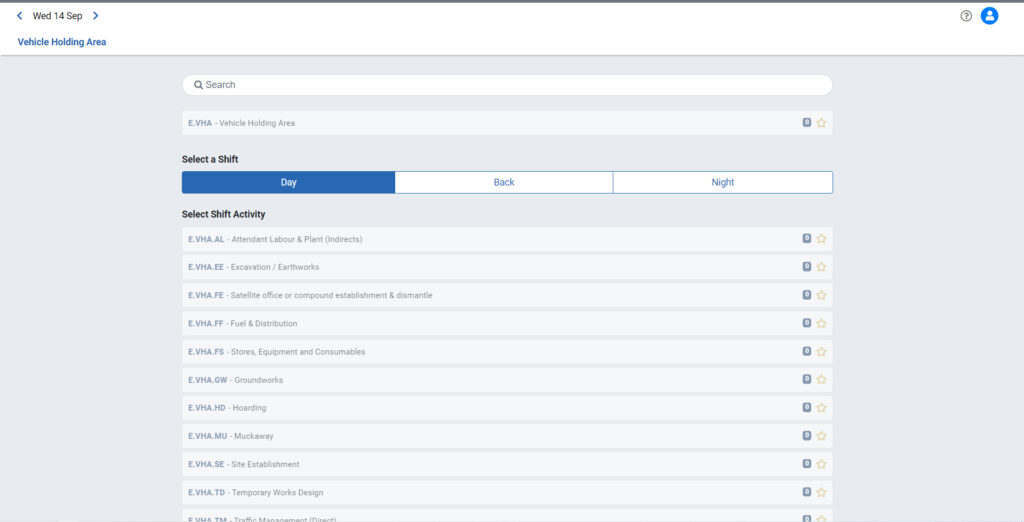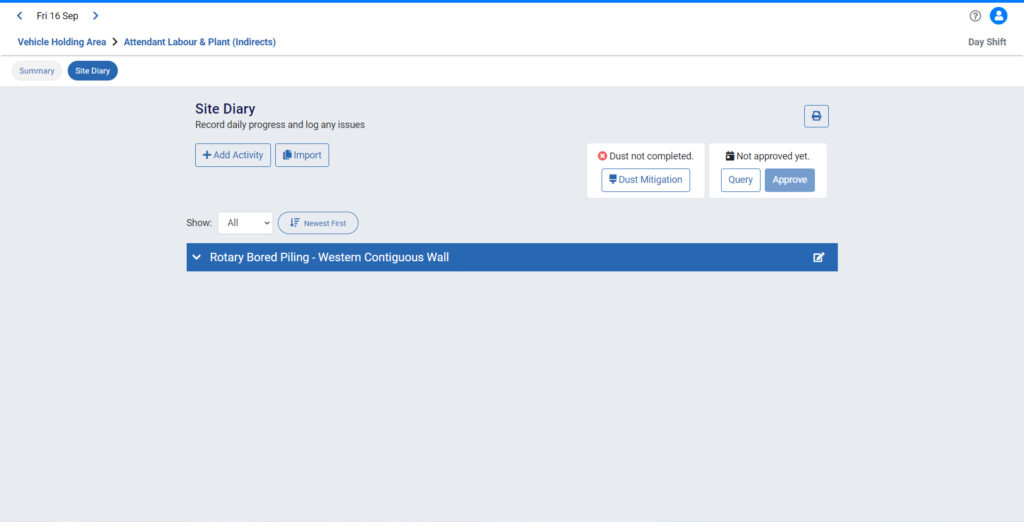
The Site Diary Application
Using their industry expertise and in close collaboration with tier one clients, Ishango have developed a site diary web application for use in the engineering and construction industry.
The site diary process is already well embedded in the industry, with engineers completing paper based diaries on a daily basis. The Ishango site diary app is a step change in the old, paper-based process and is a fully digitised, data driven solution which enables users to quickly and easily complete their site diaries, and the data produced allows management to have an overview of the project through the eyes of the engineers.

The site diary app has several key features which ensures diaries capture all pertinent information about site activities and provides a fully auditable system. The app allows users to input information about labour, plant and materials, with pictures being uploaded for each of these too. Activities can be assigned to asset codes and activity codes. Which ensures issues can be more accurately assigned to the correct activities.

Finally, there is the ability to approve site diaries by administrators in the system, this gives a sense check to the diaries and helps to ensure that the information contained in the diaries makes sense and is accurate.
Site Diary PDF Generator
A key requirement of our client was the ability to generate PDFs based on site diaries, the PDFs needed to be generated for each diary submitted so would have usually been one diary to one activity code. It was also important that the PDFs were generated at the correct time, this was usually a set time after the diary was approved.
Ishango created bespoke Python function apps to build a fully bespoke and customisable PDF generator which triggers at times set by the client. The PDF generated is fully customisable to the client’s needs, and can be created using their company templates, with company logos and branding as necessary.
Client’s needs for the PDF generation changed after time and as such they wanted PDFs generated for one asset with all activities undertaken in one PDF, rather than separate PDFs for each diary page. Ishango created a custom trigger, again using Python programming language and an Azure Function App. This trigger is built to run each hour and checks that all activity codes under an asset are approved for a shift, if they are it sends a HTTP request to the PDF generator function app with necessary information for the generation process to begin.
Building the trigger and generator in this modular fashion means that we can easily adapt to new client’s needs and deploy in a timely manner, ensuring that clients quickly realise the benefits of the site diary application.
Case Study
There are of course benefits to be achieved by fully digitising and automating a process like the site diary one. But there are further benefits to be realised between the generation of the PDF and the manual uploading by document controllers into the client’s document control system.
Previously the client would take the generated PDFs and have their document control team manually upload them to their document control system and fill in all requisite metadata. To give more context to this, the client has generated over 1000 PDFs. Each one of these had to be downloaded from one system, uploaded to another and have data manually filled in.
Ishango was approached to find a solution to avoid this manual intervention from the document controllers, whilst still uploading documents to the document control system and ensuring necessary metadate was filled in.
Through regular meetings with the client and the supplier of the document control system, Ishango got a complete set of client requirements and system capabilities. We then started building a solution which would interact between the Ishango PDF generator and the document control system.
Our solution was again built using the Python programming language and an Azure Function App using a HTTP trigger, the trigger was called whenever the PDF generator created a PDF and sent the PDFs and metadata across to the document control system. Not only does this bespoke solution mean we fully meet the client requirements which out of the box products would not be able to, but we also have a solution which is cost effective and very easily scalable should demand increase.
Also, if we put some costings and timings against the process, we can get an idea of how much money as well as time is being saved through the automated integration.
If a document controller costs a project £25 per hour and can upload and fill metadata in for six documents each hour. This means that the 1000 PDFs would take 166.66 hours to upload, which would cost the project £4166. As the generation of PDFs is increased this saving will only go up, and by embedding the site diary application at the early stage of a project, these savings can be realised much earlier.
Through this integration, this also removes the chance for human error through the incorrect typing of metadata which means there is no further work correcting mistakes later on. Which greatly reduces the risk of issues arising when auditing, or when using site diaries for any commercial dispute.
Next Steps
The application and integration has only been embedded on the project for a short period of time, but the client already has over 95% adoption and they are looking to get 100% adoption in the coming weeks. We will be working with the client to make sure the application is ready for full deployment across this large scale infrastructure project.
As the available dataset grows, so to does our ability to perform advanced analytics to reduce waste and increase productivity. A particular area of focus is around the analysis issues and material and plant usage. Through analysis trends in these categories, we can better understand both the nature of the issue and the causes.
Through a combination of site diary, P6 and external data sources, we can begin to identifying inefficiencies in the scheduling of a project and begin to identify trends or issues which lead to work being stopped.
Ishango are actively developing these advanced analytical solutions, if you’d like to be involved and find out more about the site diary web application, please do get in touch.
